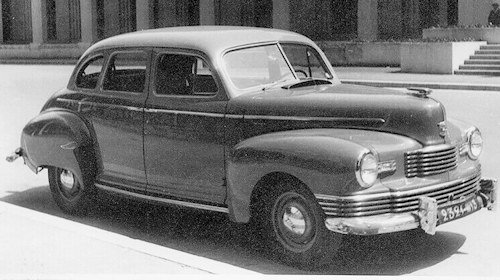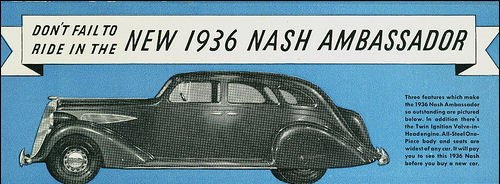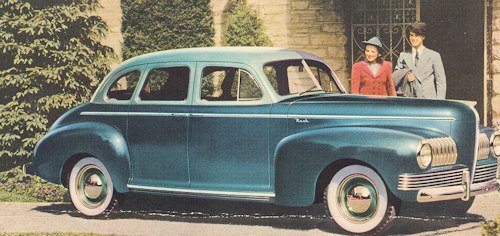Nash Ambassador 1932 to 1948
 |
|
|
Type |
motor car |
|
years |
mid 1932 to 1948 |
|
Layout |
Longitudinal front-engine, rear-wheel drive |
|
Engine |
straight 6 and 8 |
|
Wheelbase |
3175-3607 mm |
Mid-1932 Nash introduced the Ambassador Eight as a separate model, which was offered in a number of body styles - also as a coupe and Victoria.
History
The Nash Ambassador with a wheelbases of 3378 mm and 3607 mm and costly equipped, these vehicles were named for their high quality, durability, styling and high speed . They were part of the second series that Nash released in 1932 and had completely new bodies and technical improvements on all vehicles manufactured by the company fitted with a large 5.3 L straight-eight engine. Except for General Motors Nash was the only US automaker to make a profit in 1932. In 1934, Nash introduced a new styling - called "Speedstream" - which included extensive adornments on body parts and fenders in Art Deco style . The Ambassador Eight offered only a few 4-door sedan versions this year. In 1935, another facelift was carried out with even more ornaments and offered in addition to a 2-door sedan. The car now had a smaller wheelbase of 3175 mm and the smaller engine of the earlier model Advanced Eight . The huge classic forms of 1930-1934 were forever gone for Nash.

While the Ambassador was offered from mid-1932 to 1935 only with Nash's inline eight-cylinder engine, there was in the Ambassador Six of 1936, the largest straight-six from Nash, in a model with 3073 mm wheelbase, which previously knew as Advanced Six. 1937 Nash merged with the Kelvinator Corporation and Charlie Nash's handpicked successor George W. Masonbecame president of the new Nash-Kelvinator Corporation. In the same year, the coupes and convertibles returned to the Ambassador series. Since 1935, the big Nash models had had similar bodies built on the longer chassis, as well as the same bonnets, fenders (and certain ornaments) that distinguished the more expensive eight-cylinders from the cheaper six-cylinders.
In early 1937 even the cheap LaFayette was included in this scheme. This principle was used until the last AMC Ambassador 1974, with the exception of the years 1962-1964, when the Rambler Ambassador and the Rambler Classic hadthe same chassis and the same vehicle front.

Only in the model year 1941 all Nash models with long and short chassis bore the name Ambassador. The Nash Ambassador 600 with a wheelbase of 2845 mm was the first mass-produced automobile with monocoque construction. From 1941 to 1948, the Nash Ambassadors were made with this monocoque construction (frame and body welded) built on a conventional second frame, making them incredibly stiff and solid automobiles. The Ambassador 600 of 1941 was also the only Ambassador, which was powered by a side-drive engine (L-Head). In the (war-related) short model year 1942 Nash remained with this construction, whereby the 600 was no longer called Ambassador.
As ordered by the US government, Nash ceased passenger car production during the Second World War (1942-1945). When production was resumed after the war, there were no more eight-cylinder models in the model range. The 1946 Ambassador Six was now the largest model of Nash.In the area of the Soviet occupation zone, a copy of an Ambassador 1948 is said to have served as a template for an in-house development (Horch 920 S). However, only two prototypes were created in 1950 ("IFA factory VEB Horch").
